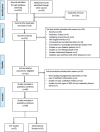Impact of Ramadan Diurnal Intermittent Fasting on Hypoglycemic Events in Patients With Type 2 Diabetes: A Systematic Review of Randomized Controlled Trials and Observational Studies
- PMID: 33763029
- PMCID: PMC7984365
- DOI: 10.3389/fendo.2021.624423
Impact of Ramadan Diurnal Intermittent Fasting on Hypoglycemic Events in Patients With Type 2 Diabetes: A Systematic Review of Randomized Controlled Trials and Observational Studies
Abstract
Ramadan is the 9th month of the lunar calendar during which Muslims abstain from food and drink between dawn and sunset for 30 consecutive days. Ramadan fasting is observed by all healthy Muslim adults, as well many Muslims with type 2 diabetes (T2DM). Hypoglycemic events (HE) are a serious complication associated with diabetes management and are associated with increased cardiovascular disease risk. Conflicting results have been reported concerning the incidence of HE among people with T2DM observing Ramadan fasting. This review summarizes available scientific evidence on the occurrence of HE and the effects of different moderators on the incidence of HE among patients with T2DM during Ramadan. We conducted a systematic review of available observational studies and randomized controlled trials (RCTs) for patients with T2DM who fasted during Ramadan, with HE as the primary outcome. Ten databases were searched for relevant studies from inception until October 31, 2020. In total, 68 studies (35 RCTs and 33 observational studies) met the inclusion criteria. Non-sulfonylureas hypoglycemic medications showed superior effects in lowering the incidence of HE over sulfonylureas hypoglycemic medications. Variable moderators were associated with experiencing HE during Ramadan in both observational studies and RCTs, including sex, geographical location, body anthropometric indicators, season, dietary behaviors, fasting duration, time since diagnosis, and pre-fasting education. This comprehensive systematic review covered the largest number of observational and clinical studies investigating the impact of Ramadan on HE among patients with T2DM. The study highlights the significance of different moderators that influence the effect of Ramadan fasting on HE, including dietary behaviors, fasting time duration, sex, season, country, pre-fasting education, age, and time since diagnosis. The study also highlighted the impact of different hypoglycemic medications on HE and noted the superiority of non-sulfonylureas over sulfonylureas hypoglycemic medications in lowering the risk for hypoglycemia in people with T2DM during Ramadan fasting.
Keywords: caloric restriction (CR); diet; glucose; hypoglycemia; lifestyle; mealtime.
Copyright © 2021 Abdelrahim, Faris, Hassanein, Shakir, Yusuf, Almeneessier and BaHammam.
Conflict of interest statement
The authors declare that the research was conducted in the absence of any commercial or financial relationships that could be construed as a potential conflict of interest.
References
-
- Hassanein M, Al-Arouj M, Ben-Nakhi A, Jabbar A, Hanif W, Al-Madani A. Diabetes and Ramadan: practical guidelines International Diabetes Federation (IDF) in collaboration with the Diabetes and Ramadan (DAR) International Alliance. Diabetes Res Clin Practice (2016) 126:303–16. 10.1016/j.diabres.2017.03.003 - DOI - PubMed
-
- Gilani A, Davies M, Khunti K. Religious fasting, Ramadan and hypoglycemia in people with diabetes. Diabetic Hypoglycemia (2014) 7(1):15–9.
-
- Brian J, Mehtab S. The Future Global Muslim Population. Projections (2010) 2030.
-
- Saeedi P, Petersohn I, Salpea P, Malanda B, Karuranga S, Unwin N, et al. . Global and regional diabetes prevalence estimates for 2019 and projections for 2030 and 2045: Results from the International Diabetes Federation Diabetes Atlas, 9th edition. Diabetes Res Clin Pract (2019) 157:107843. 10.1016/j.diabres.2019.107843 - DOI - PubMed
-
- Salti I, Bénard E, Detournay B, Bianchi-Biscay M, Le Brigand C, Voinet C, et al. . A population-based study of diabetes and its characteristics during the fasting month of Ramadan in 13 countries: results of the epidemiology of diabetes and Ramadan 1422/2001 (EPIDIAR) study. Diabetes Care (2004) 27(10):2306–11. 10.2337/diacare.27.10.2306 - DOI - PubMed
Publication types
MeSH terms
Substances
LinkOut - more resources
Full Text Sources
Other Literature Sources
Medical
Miscellaneous


